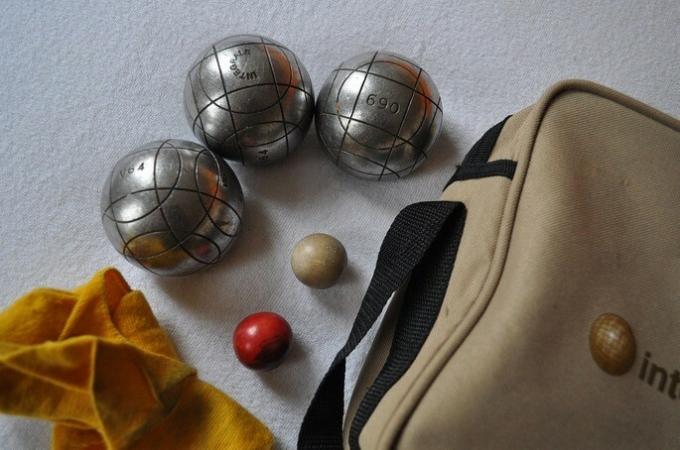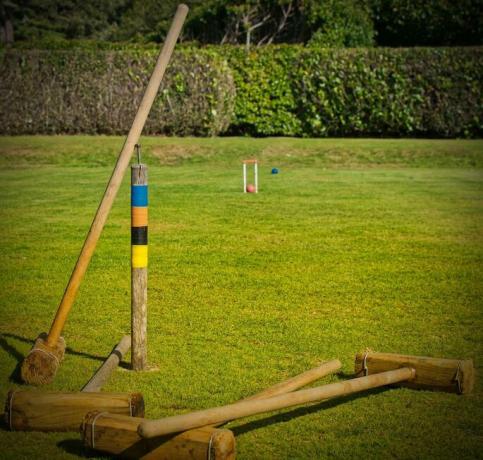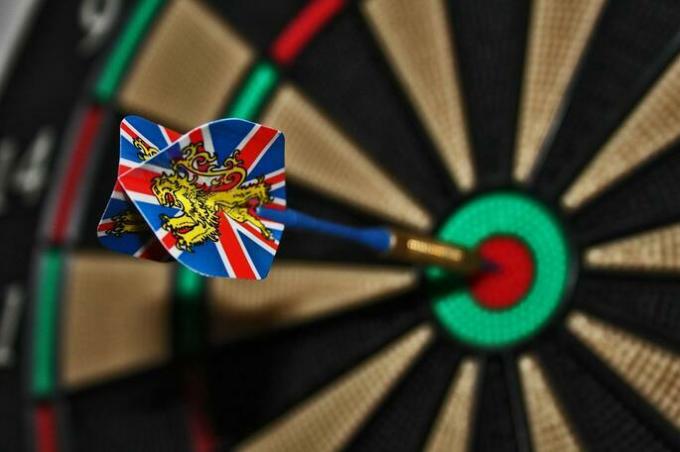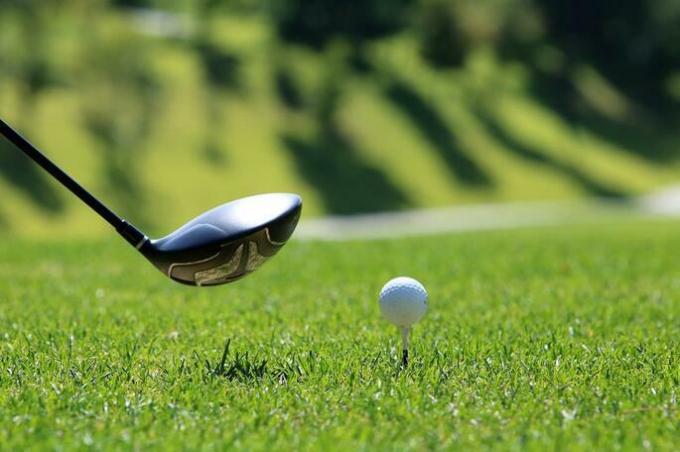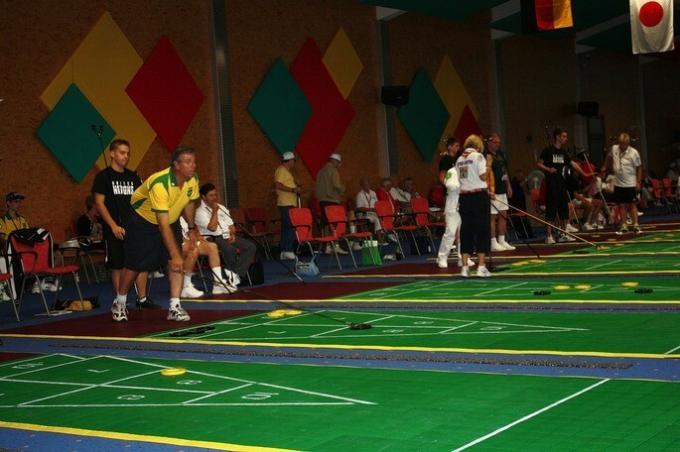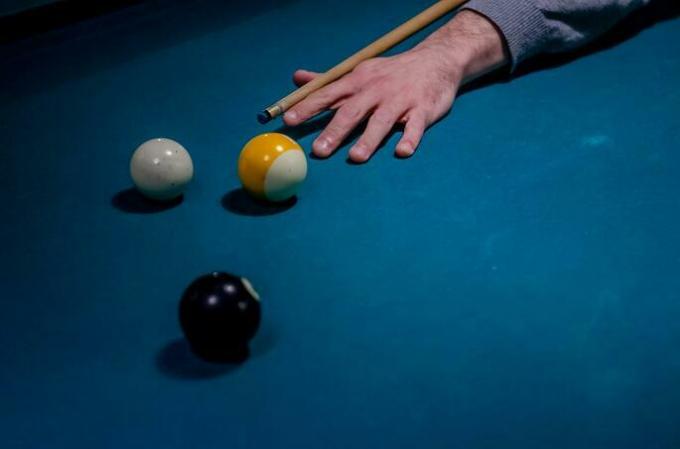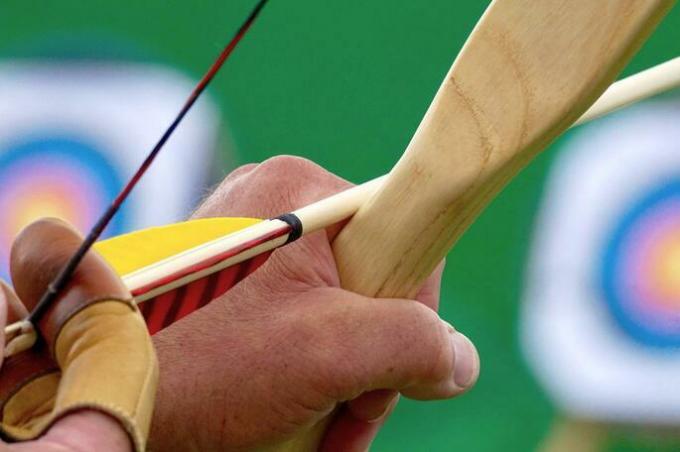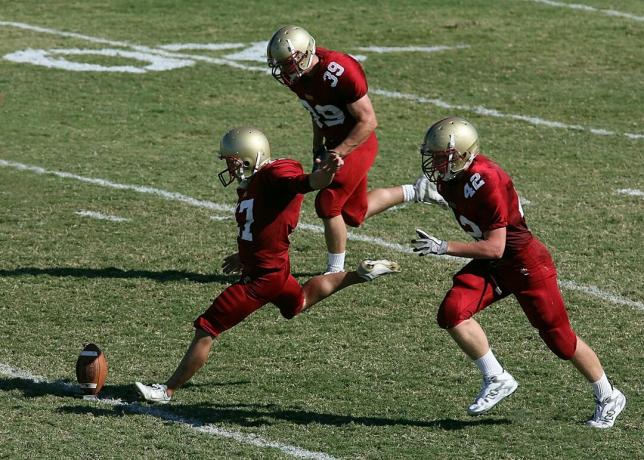Precision sports constitute a category of sports whose main objective is to hit a target from the launch of a certain object.
Some characteristics of these sports are:
- There are two types of targets: the static, which is fixed, and the mobile, which moves during the game.
- As for the number of players, they can be individual, such as snooker or archery, or collectives, such as curling.
- In precision sports, core competencies are the concentration and, above all, the aim.
Examples of precision sports:
1. bocce
There is historical evidence that boules-like modalities were practiced several millennia ago in Egypt, Greece and Turkey.
The form of bocce as we know it today was developed in Italy, where, in 1983, the main organizer of the sport, the Confederazione Boccistica Internazionale (CBI).
The sport consists of playing the boules (balls) as close as possible to a bolim (small ball) previously thrown into the court (block). The opponent, in turn, must try to throw his balls even closer to the opponent.
bolim or remove your opponents' balls. wins the set (match) whoever has the ball closest to the bolim.The sport can be played individually or by teams of up to four players. Each player or team is entitled to four balls per match. The courts must be approximately 30 meters long and four meters wide.
2. Bowling
Bowling originated in the 3rd century in Germany. However, there are indications that very similar sports would have been practiced approximately seven thousand years ago in Egypt and Polynesia.
The current bowling rules were created in 1887, in the USA, with the formation of the National Bowling Association (NBA).
The dynamics of the sport consists of throwing a ball over a track to knock down ten pins aligned in a triangle shape at its end. A match lasts ten frames (rounds) consisting of two moves.
When all the pins are knocked down, the strike, which is worth ten points. If the strike happen on the first play frame, the player earns the right to play two more balls. The player or team that knocks down the most pins at the end of the game wins.
In the middle of the last century, with the development of automated mechanical tracks and the transformation of spaces intended for As a sport in true entertainment centers, bowling lived its heyday, becoming a competitive and recreational sport for the masses. In the USA.
3. cornhole
O cornhole (“corn hole” in Portuguese), also known as bag ("bag") or "bean bag game" is a precision sport that emerged in the 19th century in the USA. Very popular in the Midwest region of the United States, the sport is usually practiced recreationally and competitively in various spaces, such as parks, bars and universities.
The game is played individually or in pairs. Each team or player is entitled to four 440g bags in different colors, filled with beans or corn, which must be thrown, alternately, on a wooden platform (top board) with a hole.
The distance from the launch line to the platform can vary between eight and ten meters, depending on the competition. Bags that hit the platform and remain on it earn a point. The bags that do not reach the top board do not score points. Bags that pass through the hole receive three points. The competitor can also, in his throw, knock the opponent's bag off the platform, preventing him from scoring points.
The team or player who first reaches the 21-point mark wins the game.
4. croquet
O croquet was invented around 1830 in Ireland, inspired by golf. Throughout the 19th century, it was one of the favorite recreational games of the English aristocracy, spreading throughout the British colonies.
Its moment of greatest notoriety occurred in 1900, when it was included among the Olympic modalities of the 1900 Games in Paris, which was never repeated.
The game, which can be played by doubles, trios or teams with up to six players, consists of hitting a ball with a club, in order to drive it under the arches spread across the field with the fewest strokes possible.
Behind the first arch and in front of the last, a stake is placed, which must also be touched with the ball. Once the stake is reached, the player must resume the loop of the arcs in the opposite direction.
The nine arches are arranged in a double diamond shape on a generally grassy field with no fixed dimensions. The ball is made of wood or synthetic material and the bats or pasta are made of wood.
5. curling
O curling It has its origins in Scotland in the 16th century. However, its rules were only written and made official in the 19th century, in 1838.
The sport was introduced to the world by the Scots during the 1924 Winter Olympics in Chamonix, France.
The game is played by two teams with four players each. To beat the opposing team, the player must push a massive 20 kg granite stone, known as the stone of the curling, on a long ice rink towards a circular target known as Casa, Lar (House). the middle of Casa, Lar It is known as button (button).
While one of the players throws the disc towards the target, the other players must sweep the track so that the stone does not have its trajectory deflected by the pebbles (droplets of frozen water on the track).
The ice rink is 46 meters long and five meters wide. Each Casa, Lar is 33 meters away from each other.
The game consists of ten ends (rounds) with a break at the end of the fifth. On a end, each of the four players is entitled to throw two discs at the target. they start at hack (starting point of the track) and push the stone, directing it. Players must drop the stone before the hogline. Any stone that touches the edge of the track or crosses the Casa, Lar will be out of the game.
To score in curling, the stones must reach the Casa, Lar. The team that has the closest stones to the button.
6. Darts
Darts is a precision sport originated in England whose origin dates back to the Middle Ages. There is no exact information on when or where it would have appeared, but it is often said that it would have been practiced by soldiers in the intervals of battles, when they would train their marksmanship by throwing pieces of arrows at tree trunks cut along the way. quite.
Over the centuries, the sport has become popular, being played recreationally in bars around the world, as well as in professional competitions.
Darts is an individual sport. The two opponents are separated by a line (ok) 2.37 meters from the circular target they are trying to hit with darts.
A match consists of legs (rounds) that vary in number depending on the tournament. In each leg players are entitled to three shots.
Both players start the game with 501 points. The athlete who clears the score first wins the leg. Whoever gets the most number of points wins the game. legs.
7. Golf
The word "golf" comes from the English golf, which in turn derives from the German kolbe, which means "taco".
Golf emerged in Scotland around 1400. Scotland's natural conditions were fundamental to the development of golf. In the large fields of undergrowth, holes were made and balls were thrown with wooden clubs.
Golf is a sport practiced close to nature and commonly associated with the wealthier classes. From the beginning, the objective of the game is to hit the ball into several holes using a club. Whoever hits all the holes in the fewest strokes wins the game. Currently, the goal is to hit nine or 18 holes.
The field measures between 2500 and 5000 square meters and has different game situations: sandbar, obstacles with water (lake or watercourse), tall grass and low grass, close to the ground. Different clubs are used for different moments of the game.
Typically, it takes a golfer three to five strokes to hit a hole. When the player hits the hole with just one stroke, that play is called a play. hole in one. It is a perfect shot, very difficult to make, and for this reason it is usually awarded in competitions.
8. shuffleboard
O shuffleboard is an individually played precision sport derived from the game slide-groat, which appeared in England in the 15th century.
The first sports club was formed in 1924, in Florida, USA, the St. Petersburg Shuffleboard Club. Four years later, the members of that club standardized the rules, consolidating the current form of the shuffleboard.
The heyday of the sport in the USA, the country where it became more popular, took place in the middle of the last century, when it came to count with hundreds of clubs and thousands of practitioners only in the state of Florida. Between the 1970s and 1990s, the sport suffered from a period of decline. In recent years, however, the shuffleboard regained some popularity, falling in the taste of the nostalgic young people known as hipsters.
The dynamics of the game consists of throwing discs with the help of a club, so that they slide over a track and stop in the scoring zone, located at the other end of the track.
To add more points, it is allowed to move the opposing discs from the scoring zone, which has a triangular shape and where the scores (10, 8, 7 and -10) are entered.
The game consists of eight frames (rounds) in which players throw four discs each. The player with the most number of frames conquered.
9. snooker
Snooker is a Brazilian precision cue, table and ball sport variant of British billiards. The word "snooker" even derives from the English snooker.
The game is played by two athletes (or two pairs), who seek to pocket the colored balls in the six holes of the table.
Players must use the bat to hit the white ball (cuttle) which, in turn, will push the colored balls into the pockets (holes).
The balls must be pocketed in the ascending order of points: ball one, red; ball two, yellow; ball three, green; ball four, brown; ball five, blue; six ball, pink; seven ball, black.
After hitting a ball in the hole, the player has the right to attempt to pocket any other colored ball. If he hits, he is forced to return to the ball in turn.
At the beginning of the game, the balls are arranged on the table in a semicircle called “D”, in a longitudinal line and in two transversal ones. At the end of the game, the one with the most points wins.
10. archery
Archery is a sport that emerged in the dawn of civilization as an activity related to hunting and war.
At the beginning of the Modern Age, the military use of archery gave way to firearms, and its practice then became a sport.
The sport was part of the Olympic Games from 1900 to 1920, with a break in the 1912 Games. It returned to the Olympics in its current configuration in 1972.
The objective of the game is simple, but not easy: hit the arrows in the center of a target placed 70 meters away.
In archery we have individual trials or in teams of three archers. In the first phase of the competition, the athletes who obtain the best result after 72 arrows advance to the next phase.
The archer then has 40 seconds to fire each of his six arrows. In the finals, the athlete has only 20 seconds to shoot three arrows.
The score ranges from one to ten depending on how close the target's center circle is.
11. Shooting Sports
Sport shooting is the generic name given to a set of competitive sports practiced with firearms or compressed air, such as pistols, rifles and shotguns. These sports emerged in the 13th century, in German shooting clubs, and soon spread around the world. They have participated in the Olympic Games since their first modern edition in 1896.
Sport shooting games have undergone numerous transformations in the last century, with the alteration, addition and even exclusion of modalities. In the last Olympics, the modalities disputed were:
- Rifle at 50 meters three positions (male and female)
- 10 meter air rifle (male and female)
- 25 meter rapid fire pistol (men) and 25 meter pistol (women)
- 10 meter air pistol (men and women)
- sketch (male and female)
- trap (male and female)
In sport shooting, athletes must hit fixed or moving targets and score points according to the accuracy of their shots. Depending on the characteristics of the test, the player shoots at targets with distances between ten, 25 or 50 meters.
The biggest Olympic medalists in sport shooting are the USA, China and Russia. Brazil has four medals: one gold, two silver and one bronze. The 1920 gold medal was the first won by a Brazilian in an Olympics, Lieutenant Guilherme Paraense.
Bibliography:
- BARRETO, Marcelo; FREITAS, Armando. Olympic Almanac: Everything you need to know about sports and the Olympics. Sao Paulo: Leya, 2016.
- MASS, Marcel. Introduction to team sports. São Paulo: EACH/USP, 2020.
- NETO, Francisco P. M. Sports marketing: sport as a modern marketing tool. São Paulo: Bestseller, 2020.
- TURBINO, Manuel. What is sport. Sao Paulo: Brasiliense, 2017.
Read too:
- Invasion sports: what they are, features and 10 examples
- what are sports
- 7 types of sport

